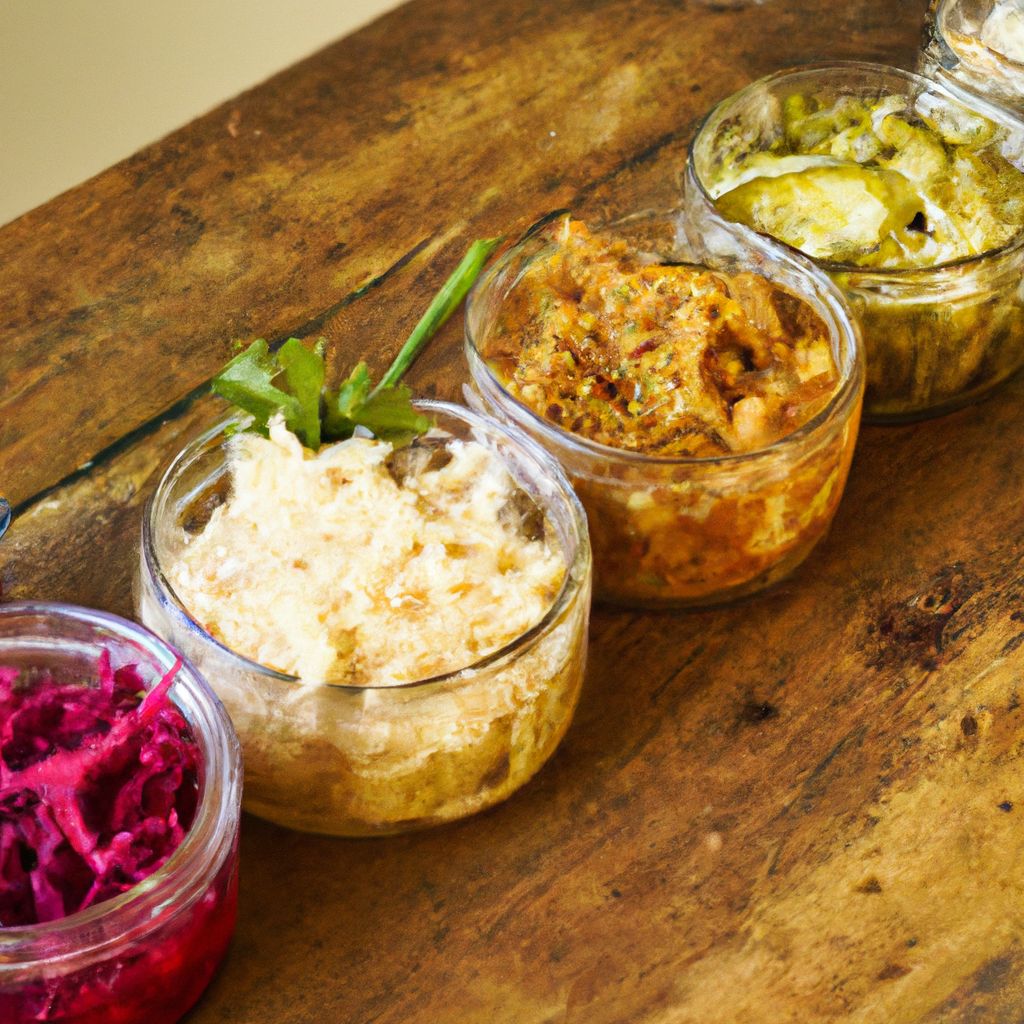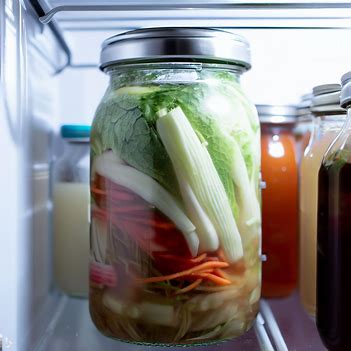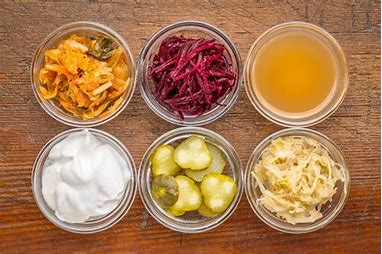Introduction: A Flavorful Journey into Cultured Foods
Welcome to the exciting world of cultured foods, where health meets taste in a harmonious dance of flavors and benefits. In this gastronomic revolution, we’re leaving behind the bland and embracing the tangy, the effervescent, and the downright delicious. Say goodbye to mundane diets and join the culinary adventure of cultured foods.
The Benefits of Cultured Foods: More Than Just a Tasty Bite
In the enchanting world of cultured foods, where flavors dance on your palate, there’s more at play than meets the eye—or, in this case, the taste buds. Beyond the delightful tang and fizz, these foods pack a powerful punch of health benefits, turning every bite into a step towards a healthier, happier you.
Gut Health Marvels: A Symphony of Good Bacteria
Imagine your gut as a bustling metropolis, and cultured foods as the friendly residents keeping everything in order. These foods are rich in probiotics—those friendly bacteria that set up shop in your digestive system, promoting a thriving environment. A happy gut means better digestion, reduced inflammation, and an immune system that’s ready to tackle anything life throws at it.
Real-life analogy: It’s like having a superhero squad in your digestive system, ready to defend against the villains of illness and discomfort.
Enhanced Nutrient Absorption: Unlocking the Goodness
Cultured foods not only introduce beneficial bacteria but also unlock the nutritional potential of the foods you consume. The fermentation process breaks down complex compounds, making nutrients more accessible to your body. It’s like having a culinary locksmith ensure that your body can easily absorb and make use of the valuable vitamins and minerals present in your food.
Real-life analogy: Cultured foods act as the key that unlocks the treasure chest of nutrients in your meals, ensuring you get the most out of every bite.
Mood-Boosting Prodigies: Happy Gut, Happy Mind
Believe it or not, the state of your gut can influence your mood. The gut-brain connection is a fascinating aspect of our biology, and cultured foods play a starring role. The good bacteria in your gut can produce neurotransmitters like serotonin, the feel-good hormone. So, indulging in cultured foods isn’t just about a happy tummy; it’s about fostering a positive state of mind.
Real-life analogy: Think of your gut as the conductor of a mood orchestra, with cultured foods ensuring a harmonious symphony of serotonin production.
Digestive Harmony: Bye-Bye Bloating and Discomfort
Are you tired of feeling bloated and uncomfortable after meals? Cultured foods might be your digestive knight in shining armor. The probiotics they bring to the table aid in breaking down complex carbohydrates and sugars, reducing the likelihood of bloating and gas. It’s like having a digestive troubleshooter, ensuring that your meals are a source of nourishment, not discomfort.
Real-life analogy: Cultured foods act as the digestive maestros, orchestrating a smooth digestion symphony and leaving you feeling light and satisfied after every meal.
Immune System Fortification: The Shield Against Illness
In the midst of a health-conscious era, having a robust immune system is non-negotiable. Cultured foods are your immune system’s best friend. The beneficial bacteria they introduce help regulate the immune response, ensuring it’s ready to defend against invaders. It’s like having a personal bodyguard for your well-being.
Real-life analogy: Cultured foods are the vigilant guardians of your immune system, standing strong against the armies of pathogens that seek to disrupt your health.
Balancing Act for the Microbiome: A Happy Ecosystem
Your gut is a complex ecosystem, and like any ecosystem, it thrives on balance. Cultured foods contribute to this delicate equilibrium by promoting a diverse and flourishing microbiome. This diversity is associated with overall health, from metabolic functions to mental well-being.
Real-life analogy: Your gut is like a thriving rainforest, and cultured foods are the biodiversity champions, ensuring every species (or bacteria) plays its part in maintaining the ecosystem’s balance.
In conclusion, the benefits of cultured foods go far beyond their tantalizing taste. They’re the unsung heroes of our health, working tirelessly to create a harmonious balance in our bodies. So, the next time you savor the tang of kimchi or relish the effervescence of kombucha, know that you’re not just enjoying a tasty bite; you’re indulging in a feast of well-being that transcends the boundaries of your taste buds.
The Different Types of Cultured Foods: A Symphony of Flavors

Imagine walking through a culinary wonderland, each step accompanied by the enticing aromas of diverse and delightfully cultured foods. This gastronomic symphony is a testament to the incredible variety that falls under the umbrella of cultured delights. From the tangy to the savory, the effervescent to the creamy, there’s a cultured food for every palate.
1. Kimchi: The Zingy Dance of Korean Fermentation
Step into the vibrant world of Korean cuisine, with kimchi leading the way. This spicy, fermented cabbage dish is a staple in Korean households, known for its unique combination of flavors. The marriage of chili peppers, garlic, ginger, and cabbage undergoes a fermentation dance that transforms it into a zesty, probiotic-packed side dish. Whether as a topping for rice or a standalone snack, kimchi is a flavor explosion that’s hard to resist.
2. Greek Yogurt: Creamy Elegance in Every Spoonful
Picture a velvety spoonful of Greek yogurt, and you’re entering the realm of cultured foods with sophistication. Unlike its runnier counterparts, Greek yogurt undergoes a straining process, resulting in a thick, creamy texture that’s rich in probiotics.
It’s not just a breakfast option; it’s a versatile ingredient that adds a touch of elegance to both sweet and savory dishes. Top it with honey and nuts for a sweet treat, or use it as a tangy base for savory sauces.
3. Fermented Pickles: Crunchy Bites of Probiotic Goodness
Crunch into a perfectly fermented pickle, and you’re biting into more than just a snack. These tangy delights are cucumbers transformed through the magic of fermentation.
The crispness of the pickle meets the tanginess of the brine, creating a symphony of textures and flavors. Packed with probiotics, these pickles not only satisfy your snack cravings but also contribute to a healthier gut.
4. Kefir: The Effervescent Elixir of Gut Health
Move over, traditional beverages; kefir is here to steal the spotlight. This fermented milk drink boasts a bubbly effervescence, making it a delightful alternative to plain milk.
The fermentation process involves kefir grains and a symbiotic culture of bacteria and yeast (SCOBY), which transforms milk into a tangy, probiotic-rich elixir. Sip on a glass of kefir for a refreshing twist to your daily dairy intake and a boost to your digestive health.
5. Kombucha: Fizzy Tea with a Probiotic Punch
Picture a fizzy, fermented tea that’s not just a drink but a wellness elixir—meet kombucha. This trendy beverage starts as sweetened tea, fermented with the help of a SCOBY. The result is a lightly effervescent drink with a slightly tangy taste.
Beyond its refreshing flavor, kombucha is celebrated for its probiotic content, making it a go-to choice for those looking to invigorate their gut health with a tasty twist.
6. Sourdough: The Artisanal Bread with a Fermented Twist
For bread enthusiasts, sourdough is the epitome of artisanal craftsmanship. The magic happens when wild yeast and lactobacillus bacteria naturally present in flour create a symbiotic dance of fermentation.
The result is a bread with a chewy crust, a soft interior, and a distinctive tangy flavor. Beyond its deliciousness, sourdough is considered by many to be a healthier bread option due to its fermentation process, which breaks down gluten and phytic acid.
7. Miso: Umami Magic in a Bowl
Enter the umami-rich world of miso, a staple in Japanese cuisine. This fermented soybean paste is renowned for its depth of flavor and versatility. Miso soup, a classic Japanese dish, is just the tip of the iceberg. Miso finds its way into marinades, dressings, and even desserts, offering a unique blend of saltiness, sweetness, and that elusive umami kick.
8. Yogurt: From Breakfast Staple to Culinary Chameleon
Yogurt, the old faithful of the cultured foods family, deserves its own spotlight. Whether enjoyed with granola in the morning, blended into smoothies, or used as a base for savory sauces, yogurt is a culinary chameleon.
Packed with probiotics, it not only enhances the flavor of dishes but also contributes to gut health, making it a versatile and health-conscious addition to your culinary repertoire.
In this symphony of flavors, each cultured food plays a unique note, contributing to the overall harmony of a well-rounded, delicious diet. From the spicy kick of kimchi to the creamy elegance of Greek yogurt, these foods not only tantalize the taste buds but also provide a myriad of health benefits.
So, as you embark on your culinary journey, don’t just savor the flavors—immerse yourself in the symphony of cultured foods and let your palate dance to the rhythm of wellness.
How to Incorporate Cultured Foods into Your Diet: A Seamless Integration

Alright, buckle up for a taste revolution! If you’re ready to infuse your diet with a burst of flavor and a heap of health benefits, incorporating cultured foods is the way to go. The best part? It’s easier than you think. Let’s dive into the art of seamlessly integrating these culinary wonders into your daily meals.
- Morning Kickstart with Yogurt: Breakfast is the perfect canvas to kickstart your day with cultured goodness. Swap that sugary cereal for a bowl of Greek yogurt. Top it with a handful of fresh berries, a drizzle of honey, and a sprinkle of granola for an explosion of flavors that will leave you satisfied and ready to conquer the day.
- Snack Attack with Kimchi and Pickles: Say goodbye to boring snacks and welcome the crunch of pickles and the kick of kimchi. Keep a jar of fermented pickles in the fridge for a quick, guilt-free snack. Slice them up and pair them with hummus or your favorite dip for a snack attack that’s as satisfying as it is wholesome.
- Lunchtime Kombucha Delight: Swap out your usual sugary soda for a bubbly kombucha during lunch. Not only does it make for a refreshing beverage, but the probiotics will also aid digestion. Pick your favorite flavor from the array available at your local store, and sip your way to a healthier gut.
- Side Dish Upgrade: Sauerkraut and Beyond: Elevate your lunch or dinner with the addition of sauerkraut or other fermented veggies as a side dish. The tangy goodness pairs well with grilled meats, sandwiches, or even a simple bowl of rice. It’s an effortless way to add a burst of flavor and health to your meals.
- Dress It Up with Cultured Dressings: Turn your salads into a culinary masterpiece with cultured dressings. Opt for yogurt-based dressings or experiment with kombucha vinaigrettes. Not only will your taste buds thank you, but your body will also benefit from the probiotics in these homemade dressings.
- Smoothies with a Probiotic Twist: Upgrade your smoothie game by adding a scoop of probiotic-rich yogurt or kefir. Blend it with your favorite fruits for a creamy, dreamy concoction that not only satisfies your sweet tooth but also nurtures your gut health.
- Dessert Time with Frozen Yogurt: Who said desserts can’t be healthy? Indulge in your sweet cravings with frozen yogurt. Top it with fresh fruits, nuts, or a drizzle of dark chocolate for a guilt-free treat that feels like a cheat day but is loaded with probiotics.
- Homemade Fermented Treats: Take it a step further by incorporating homemade fermented treats into your diet. Experiment with fermenting your own vegetables, making kefir at home, or trying your hand at kombucha brewing. The satisfaction of creating your own cultured delights is unparalleled.
Remember, the key to seamlessly integrating cultured foods into your diet is to get creative and make it enjoyable. Cultured foods aren’t just about health; they’re about enhancing the pleasure of eating. So, embark on this delicious journey, experiment with flavors, and let your meals become a celebration of taste and well-being. Your taste buds and your gut will thank you for it!
The Best Foods to Culture at Home: Crafting Your Culinary Masterpieces

Welcome to the heart of the cultured food movement—your own kitchen. The joy of cultivating your own culinary creations not only puts you in control of what you consume but also adds a personal touch to your meals. Let’s delve into the DIY delights of home culturing and explore some of the best foods to culture in your own kitchen.
1. Sauerkraut: A Crunchy Fermented Classic
Imagine a jar filled with vibrant, crunchy cabbage that transforms into a tangy delight. Sauerkraut, a time-honored tradition, is a staple in the world of home culturing. Rich in probiotics and bursting with flavor, making sauerkraut at home is surprisingly simple. All you need is cabbage, salt, and a bit of patience.
2. Yogurt: Creamy Goodness Straight from Your Kitchen
No list of home-cultured wonders is complete without yogurt. Creamy, versatile, and packed with probiotics, homemade yogurt allows you to control the ingredients and experiment with different flavors. With just milk and a yogurt starter culture, you can create a velvety treat that far surpasses its store-bought counterparts.
3. Sourdough Bread: The Art of Wild Fermentation
Step into the world of artisanal baking with sourdough bread. The magic happens when wild yeast and bacteria interact with flour and water, creating a distinctive tangy flavor and chewy texture. While mastering the perfect sourdough might take some practice, the journey is as rewarding as the final loaf.
4. Kombucha: Fizzy Elixir of Health
Move over, sugary sodas; there’s a new fizzy drink in town. Kombucha, a fermented tea, is a bubbly elixir teeming with probiotics. Cultivating this effervescent wonder at home involves a symbiotic culture of bacteria and yeast (SCOBY), black tea, sugar, and a bit of waiting. The result? A refreshing, slightly tangy beverage that’s not only delicious but also incredibly good for your gut.
5. Kimchi: Spicy Fermentation with a Kick
Hailing from Korea, kimchi is a spicy and pungent delight that can elevate any meal. Typically made with fermented vegetables, the star of the show is often cabbage. Loaded with vitamins and probiotics, homemade kimchi allows you to tailor the spice level to your liking, ensuring a perfect balance of heat and flavor.
6. Pickles: A Crisp and Tangy Snack
Move beyond store-bought pickles and venture into the world of homemade pickling. Whether you opt for cucumbers, carrots, or even beets, the process is simple: a brine of water, salt, and spices does the magic. After a short fermentation period, you’ll be left with crunchy, tangy pickles that add a burst of flavor to sandwiches and salads or can be enjoyed on their own.
7. Fermented Hot Sauce: Spice Up Your Life Naturally
For spice enthusiasts, creating your own fermented hot sauce is a game-changer. Gather your favorite chili peppers, garlic, and salt, and let the natural fermentation process infuse the sauce with complex flavors. The result? A hot sauce that not only brings the heat but also the depth of flavor that mass-produced options often lack.
8. Miso: Umami in a Jar
Transport your taste buds to Japan with homemade miso paste. Typically crafted from fermented soybeans, rice, or barley, miso adds a rich umami flavor to soups, marinades, and dressings. While it requires a longer fermentation period, the payoff is that it is a versatile ingredient that will elevate your culinary creations to a whole new level.
9. Fermented Nut Cheeses: Dairy-Free Delights
For those seeking dairy alternatives, enter the world of fermented nut cheeses. Almonds, cashews, or macadamia nuts can all be transformed into creamy, flavorful cheeses through fermentation. Experiment with herbs, spices, and different nut combinations to create a spreadable masterpiece that’s as versatile as it is delicious.
10. Pickled Eggs: A Twist on a Classic Snack
Elevate the humble hard-boiled egg by giving it a cultured twist. Pickling eggs in a brine of vinegar, water, and spices adds a zesty kick to this protein-packed snack. The longer they soak, the more infused with flavor they become. It’s a simple yet delightful addition to your home-cultured repertoire.
Embark on your journey into home culturing by choosing a recipe that matches your taste preferences and skill level. The beauty of DIY delights lies not only in the end result but also in the creative process of crafting these culinary masterpieces in the comfort of your own kitchen.
As you explore the world of home culturing, you’ll not only enhance the flavor profile of your meals but also experience the satisfaction of creating something uniquely yours. So, don your apron, gather your ingredients, and let the cultured adventure begin!
The Healthiest Cultured Foods to Buy: Navigating the Supermarket Aisles
The supermarket aisles are a treasure trove of cultured delights, but not all fermented wonders are created equal. Join us on a guided tour through the labyrinth of choices as we unveil the healthiest cultured foods that deserve a spot in your shopping cart.
1. Yogurt: The Probiotic Powerhouse
As you stroll down the dairy aisle, yogurt beckons with its creamy allure. Opt for varieties labeled “live and active cultures” to ensure a generous dose of probiotics. Greek yogurt, in particular, is a standout, packing more protein and fewer sugars. Add a dollop to your morning routine for a delicious and nutritious start to the day.
2. Kombucha: Fizz and Flavor in a Bottle
Venture into the beverage section, and you’ll encounter the effervescent wonder of kombucha. This fermented tea is teeming with probiotics, offering a tasty alternative to sugary sodas. Look for brands with minimal added sugars and intriguing flavor profiles. From ginger zing to fruity infusions, kombucha is a bubbly way to boost gut health.
3. Kimchi: Spice Up Your Life and Your Gut
Head to the international foods aisle to discover kimchi, Korea’s spicy fermented cabbage dish. Packed with vitamins, fiber, and beneficial bacteria, kimchi adds a punch of flavor to your meals. Experiment with different brands and spice levels to find the perfect balance for your taste buds.
Pro tip: It’s not just a side dish; toss it into salads or rice bowls for a flavor explosion.
4. Sauerkraut: Classic Fermentation at its Best
In the canned goods section, sauerkraut awaits, a classic fermented delight that deserves a place on your plate. Rich in vitamins C and K, sauerkraut can be a tangy addition to sandwiches, hot dogs, or even as a side dish. Check the label for raw, unpasteurized options, as the pasteurization process may diminish some of the beneficial bacteria.
5. Miso: Umami Elegance in a Jar
For a journey to the Far East, explore the Asian foods aisle and discover miso paste. This Japanese staple, made from fermented soybeans, offers a burst of umami flavor. Miso is not only a culinary delight but also a source of probiotics. Use it to elevate soups, marinades, and dressings, adding a depth of flavor that goes beyond the ordinary.
6. Pickles: Crunchy Bites of Fermentation
Don’t overlook the humble pickle aisle; those crunchy delights are more than just a burger sidekick. Naturally fermented pickles, rather than those produced with vinegar, contain live cultures. Seek out options with minimal processing and low salt content for a snack that satisfies your cravings while supporting gut health.
7. Tempeh: The Protein-Packed Fermented Soy Hero
As you peruse the vegetarian and plant-based sections, encounter tempeh, a protein-rich marvel born from fermented soybeans. With a nutty flavor and firm texture, tempeh is a versatile meat substitute that can be grilled, stir-fried, or crumbled into dishes. Beyond its protein prowess, tempeh offers a dose of probiotics, making it a win-win for your taste buds and gut.
8. Fermented Dairy Alternatives: Plant-Powered Probiotics
For those on a dairy-free journey, the options abound. Fermented plant-based alternatives, like coconut or almond yogurt, provide a dairy-free twist with the same probiotic punch. Ensure the product contains live cultures and minimal additives for a wholesome dairy alternative that nourishes your gut.
Navigating with Confidence
Armed with this curated list, navigating the supermarket aisles becomes a thrilling adventure rather than a daunting task. Embrace the variety, savor the flavors, and make choices that not only tantalize your taste buds but also nurture your gut health.
The healthiest cultured foods are just a shopping trip away, ready to transform your meals into a celebration of well-being and flavor. So, don your culinary explorer hat and embark on a journey through the aisles—your gut will thank you for it.
The Risks of Consuming Too Much Cultured Foods: When Good Intentions Go Awry

In our quest for better health, it’s easy to get carried away with the allure of cultured foods. The tangy taste of kimchi and the effervescence of kombucha can be downright addictive. But, as with any good thing, moderation is the key. Let’s delve into the potential risks of overindulging in cultured foods, exploring how good intentions can take an unexpected turn.
1. Excess Calories and Sugar
Cultured foods, especially commercially available ones, may hide a not-so-healthy secret: excess calories and sugar. Flavored yogurts and sweetened kombuchas, while delicious, can pack a punch in terms of added sugars. Consuming too much of these sugary delights may lead to unwanted weight gain, an increased risk of type 2 diabetes, and other health issues. It’s crucial to read labels diligently and choose options with minimal additives.
2. Sodium Overload
While fermented foods like pickles and sauerkraut offer a burst of flavor, they often come with a side of sodium. Too much salt in your diet can contribute to high blood pressure, increasing the risk of heart disease and other cardiovascular issues. If you’re a fan of pickled delights, be mindful of your overall sodium intake and balance it with other low-sodium food choices.
3. Gastrointestinal Distress
Cultured foods are celebrated for their probiotic content, promoting a healthy gut microbiome. However, an excess of good bacteria can sometimes lead to gastrointestinal discomfort. Overconsumption may result in bloating, gas, and irregular bowel movements. It’s essential to gradually introduce cultured foods into your diet, allowing your digestive system to adjust without causing undue stress.
4. Histamine Intolerance
For some individuals, particularly those with histamine intolerance, indulging in large quantities of fermented foods can be a double-edged sword. Histamine is a naturally occurring compound in these foods, and an excess can trigger symptoms such as headaches, dizziness, and skin rashes. If you suspect histamine intolerance, it’s advisable to consult with a healthcare professional for personalized dietary guidance.
5. Interference with Medications
Cultured foods may interact with certain medications. For instance, consuming a significant amount of grapefruit, a type of cultured food in the form of kombucha, may interfere with medications like statins and anticoagulants. If you are on medication, it’s wise to consult your healthcare provider to ensure that your love for cultured foods doesn’t compromise the effectiveness of your prescribed treatments.
6. Allergies and Sensitivities
While rare, some individuals may be allergic or sensitive to specific ingredients in cultured foods. For instance, those with lactose intolerance may need to be cautious with certain cultured dairy products. Always be aware of your personal dietary restrictions and consult with a healthcare professional if you suspect any adverse reactions.
In essence, the risks of consuming too much cultured food lie in the excesses – be it in calories, sugar, sodium, or even beneficial bacteria. The key is finding a balance that suits your individual needs and preferences. It’s about savoring the goodness of cultured foods without letting good intentions turn into unintended health consequences.
So, as you embark on your cultured food journey, remember the golden rule: moderation. Enjoy the rich tapestry of flavors and embrace the health benefits, but do so with a mindful approach. Your gut, your taste buds, and your overall well-being will thank you for finding that perfect balance in the delightful world of cultured foods.
How to Tell if a Food is Properly Cultured: A Guide to Gastronomic Purity

Embarking on a cultured food journey is like stepping into a world where taste and health converge, but not all cultured foods are created equal. To ensure you’re getting the full spectrum of benefits, it’s crucial to distinguish the authentically cultured from the imitators. Here’s your comprehensive guide to gauging gastronomic purity:
Check the Ingredients List
Authentic cultured foods are made using simple, natural ingredients. When scanning the label, look for recognizable components like vegetables, salt, water, and the key player—live cultures. Be wary of additives, preservatives, or unfamiliar chemicals that might compromise the purity of the cultured experience.
Look for Live Cultures
At the heart of any cultured food’s magic are live probiotic cultures. These microscopic warriors enhance gut health and contribute to the food’s unique flavor. Check the packaging or product description for mentions of live cultures. The more, the better.
Verify the Fermentation Period
Properly cultured foods require time for fermentation to work its magic. For example, sauerkraut might take several weeks to develop its signature tang. Shortcuts may sacrifice flavor and the full spectrum of health benefits. Look for products that proudly declare their fermentation duration, signaling a commitment to the traditional process.
Inspect Texture and Appearance
Cultured foods undergo transformations during the fermentation process. For instance, pickles might become pleasantly effervescent, and yogurt should have a creamy consistency. Beware of products that look and feel mass-produced, lacking the nuanced textures that characterize genuinely cultured creations.
Aromatic Authentication
Close your eyes and inhale. Authentic cultured foods have a distinct, inviting aroma resulting from the interplay of flavors during fermentation. Whether it’s the earthy scent of miso or the tangy kick of kimchi, your nose can often be the first detector of a genuinely cultured experience.
Savor the Flavor
The proof is in the taste. Authentic cultured foods boast a depth of flavor that evolves on your palate. Whether it’s the sour punch of kefir or the umami richness of miso, each bite should be a journey. Be wary of products that taste flat or one-dimensional, as they might lack the complexity born from true fermentation.
Check for Certification
Many quality-cultured food producers obtain certifications verifying their commitment to authenticity. Look for labels such as “organic,” “probiotic,” or “fermented” from reputable organizations. These certifications are often a reliable indicator of a product’s dedication to gastronomic purity.
Beware of Mass Production
Large-scale production methods sometimes sacrifice authenticity for efficiency. If a product is produced en masse with a fast-track approach, it might compromise the nuances that make cultured foods a gastronomic delight. Artisanal or small-batch producers often prioritize quality over quantity.
Seek Artisanal or Local Options
Authenticity often thrives in the hands of passionate artisans. Explore local markets or seek out small-batch producers who pour love and expertise into their creations. These hidden gems might be your ticket to a genuinely cultured experience.
Trust Your Instincts
Finally, trust your instincts. If something feels off, it probably is. Authentic cultured foods resonate with your senses, and when you encounter the real deal, you’ll know it. Let your taste buds guide you through the rich tapestry of flavors that only true gastronomic purity can offer.
By following this guide, you’ll navigate the world of cultured foods with confidence, ensuring that each bite is not just a meal but a journey into the authentic, flavorful realm of gastronomic purity.
The Difference Between Fermented and Cultured Foods: Unraveling the Culinary Mystery
Have you ever found yourself in the grocery store, staring at shelves filled with fermented pickles, cultured yogurt, and kombucha, wondering if these terms are just different names for the same culinary magic? Join us as we unravel the culinary mystery behind the distinction between fermented and cultured foods.
Fermentation: Nature’s Culinary Alchemy
Let’s start with fermentation, a process as ancient as time itself. Fermentation is nature’s alchemy, a transformative dance orchestrated by microorganisms like bacteria, yeast, and molds. During this process, these tiny maestros convert sugars and starches into various compounds, producing tangy, effervescent, and downright delicious foods. Think of your favorite sourdough bread or tangy sauerkraut—both owe their unique flavors to the wonders of fermentation.
Culturing: The Human Touch
Now, let’s shift our focus to culturing. While fermentation is a natural process, culturing involves a human touch. Cultured foods are those crafted by introducing specific strains of beneficial bacteria or yeast to kickstart the fermentation process. It’s like curating a symphony of flavors, where we, as culinary conductors, select the perfect microbes to create the desired taste and texture.
So, Are All Fermented Foods Cultured, and Vice Versa?
Not necessarily. While all cultured foods undergo some form of fermentation, not all fermented foods are cultured. Confused? Let’s break it down.
Fermented Foods Without Culturing
Think of traditional sauerkraut, kimchi, or pickles made through wild fermentation. In these cases, the naturally present microbes on the vegetables or in the environment initiate the fermentation process without the need for added cultures. It’s like letting nature take the reins and create its own symphony of flavors.
Cultured Foods Without Visible Fermentation
On the flip side, cultured foods like yogurt or kefir may not display the bubbling, fizzing spectacle we often associate with fermentation. In these cases, specific bacterial strains are introduced to milk or other mediums, kickstarting a controlled fermentation that might not be as visually dramatic but is equally transformative in terms of taste and nutritional benefits.
The Overarching Similarity: Gut-Friendly Goodness
Whether fermented or cultured, these foods share a common denominator: they’re fantastic for your gut. The beneficial bacteria produced during fermentation or introduced through culturing are a boon to your digestive system. They promote a healthy gut microbiome, aid in nutrient absorption, and contribute to overall well-being.
Navigating the Culinary Landscape: Fermentation and Culturing in Everyday Life
In everyday terms, understanding the difference between fermented and cultured foods can enhance your culinary exploration. Next time you indulge in a jar of artisanal pickles, appreciate the wild fermentation that gives them their zest. When savoring a spoonful of Greek yogurt, acknowledge the intentional culturing that created its velvety texture and tangy taste.
Why Distinction Matters: Crafting Culinary Masterpieces
Recognizing the nuances between fermentation and culturing empowers you as a culinary enthusiast. Whether you’re experimenting in your kitchen or navigating the diverse world of store-bought delights, understanding these processes allows you to appreciate the craftsmanship behind each bite.
In conclusion, in the culinary world, fermentation and culturing are not just processes—they’re an art form. They represent the harmonious collaboration between nature and human ingenuity, producing a symphony of flavors that tantalize our taste buds and nourish our bodies. So, the next time you indulge in a fermented or cultured delight, take a moment to savor not just the taste but the culinary masterpiece unfolding in every bite.
Why Cultured Foods are the New Wave of Healthy Eating: A Culinary Revolution

In a world constantly inundated with diet fads and health trends, it’s easy to dismiss the next big thing as just another passing wave. However, when it comes to cultured foods, it’s not just a trend; it’s a culinary revolution, and here’s why.
1. Gut Health, the Epicenter of Wellness
The gut, often referred to as the body’s second brain, plays a pivotal role in overall health. Cultured foods, with their rich probiotic content, foster the growth of good bacteria in the gut. This not only aids digestion but also bolsters the immune system, making the case for cultured foods as a cornerstone of holistic well-being.
2. A Symphony of Flavors
Imagine a world where healthy doesn’t mean bland and nutritious doesn’t equate to tasteless. Cultured foods bring a burst of flavors to the table, from the bold and spicy notes of kimchi to the creamy richness of kefir. This revolution challenges the misconception that healthy eating requires sacrificing taste, offering a palate-pleasing alternative to mundane diets.
3. Diverse Nutrient Profiles
The beauty of cultured foods lies in their diverse nutrient profiles. Fermented vegetables, for instance, are rich in vitamins and minerals, while yogurt provides a calcium boost. This variety ensures that, by incorporating a range of cultured foods into your diet, you’re not just nourishing your body but doing so with a spectrum of essential nutrients.
4. Natural Preservatives
Long before refrigeration, cultures around the world relied on fermentation to preserve food. This age-old practice is making a comeback as people seek natural and sustainable ways to extend the shelf life of their favorite foods. Cultured foods, with their inherent preservation properties, reduce the need for artificial additives, contributing to a cleaner and more eco-friendly approach to eating.
5. Mental Health and the Gut-Brain Connection
Recent scientific research has unveiled the intricate relationship between the gut and the brain. Cultured foods, by promoting a healthy gut microbiome, may have a positive impact on mental health. From reducing anxiety to enhancing mood, the benefits of a well-balanced gut extend beyond physical well-being, making cultured foods a delicious ally in the pursuit of mental wellness.
6. DIY Empowerment
In a world dominated by processed and fast foods, the resurgence of home culturing represents a reclaiming of our culinary independence. Crafting your own sauerkraut or brewing kombucha at home is not just about the end product; it’s a therapeutic and empowering experience. This shift towards hands-on food preparation fosters a deeper connection with what we consume, transforming the act of eating into a mindful and fulfilling practice.
7. Sustainable Eating Practices
As awareness of sustainable living grows, so does the appeal of cultured foods. The fermentation process requires fewer resources compared to industrial food production, making it a more sustainable choice. This aligns with the values of a growing number of individuals who seek not only personal well-being but also the well-being of the planet.
8. A Back-to-Basics Approach
In the midst of complex dietary advice and conflicting health information, the simplicity of cultured foods is refreshing. This culinary revolution invites us to embrace a back-to-basics approach to eating, one that aligns with our evolutionary history and reconnects us with traditional food practices.
Concluding, the rise of cultured foods is not just a passing phase but a transformative shift in the way we perceive and approach healthy eating. It’s a rebellion against the notion that health-conscious diets are synonymous with deprivation and a testament to the fact that nourishing our bodies can be a flavorful and enjoyable experience. So, join the culinary revolution, savor the tangy delights of cultured foods, and let your journey toward a healthier, more vibrant life begin.
Conclusion: Embrace the Delicious Revolution
As we wrap up our flavorful journey into the realm of cultured foods, one thing is clear: this is not just a culinary adventure but a transformative approach to healthy living. Whether you choose to craft your own fermented wonders at home or explore the diverse offerings at your local supermarket, cultured foods are the key to unlocking a world of taste and well-being.
Join the delicious revolution today and let your taste buds savor the goodness of cultured foods. Your body will thank you, and your palate will never be the same again. Get ready to embark on a journey where health and flavor converge in a symphony of culinary delight—because, in the world of cultured foods, every bite is a step toward a healthier, more vibrant you.

